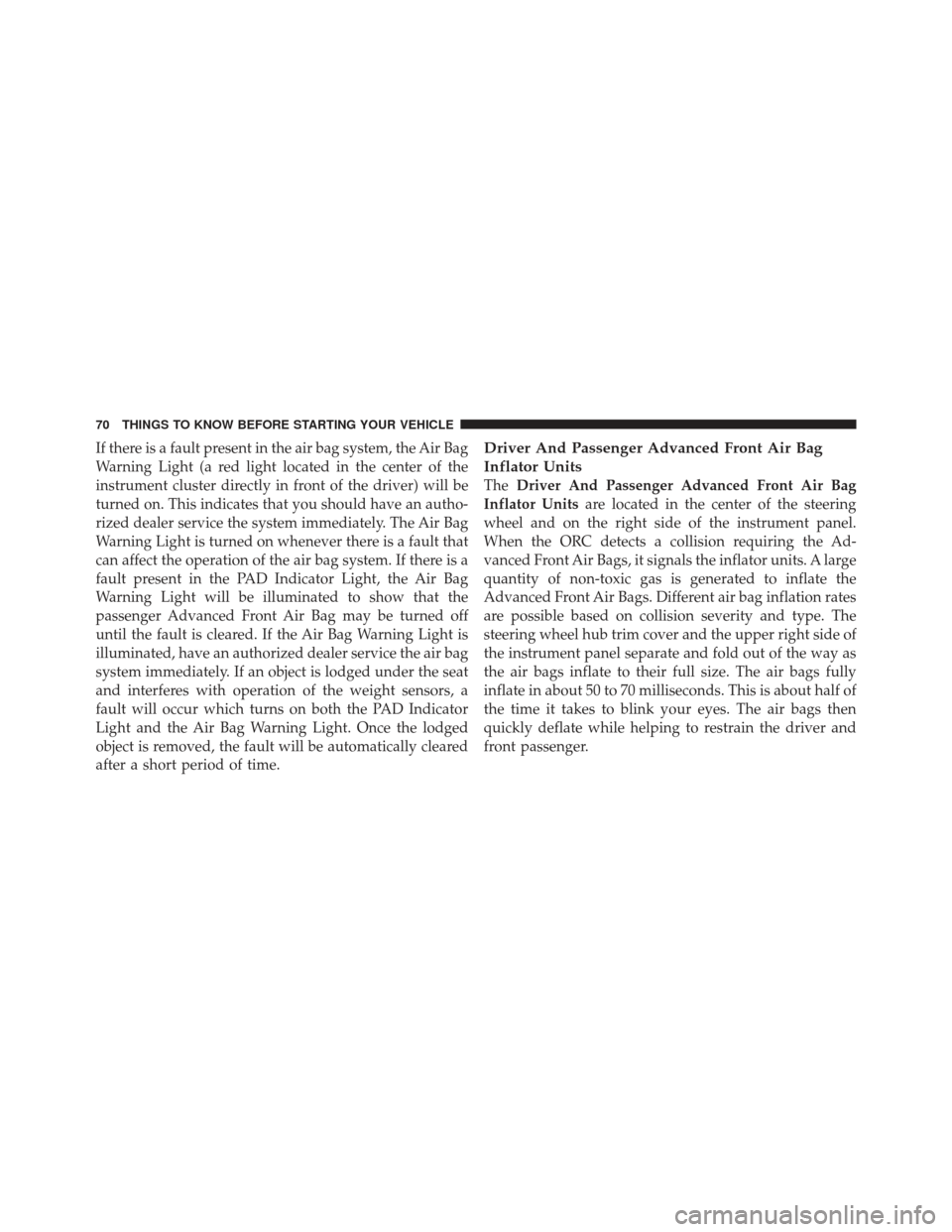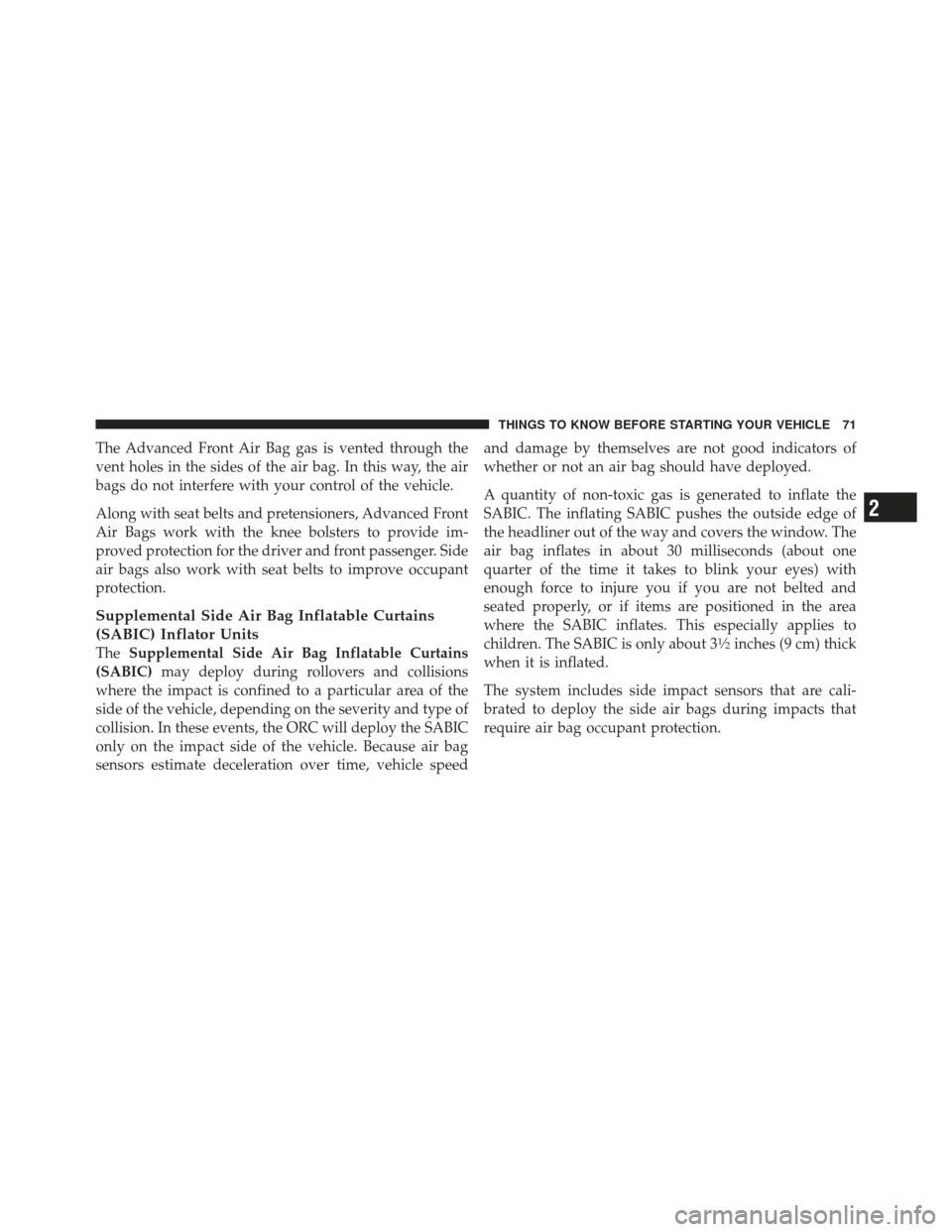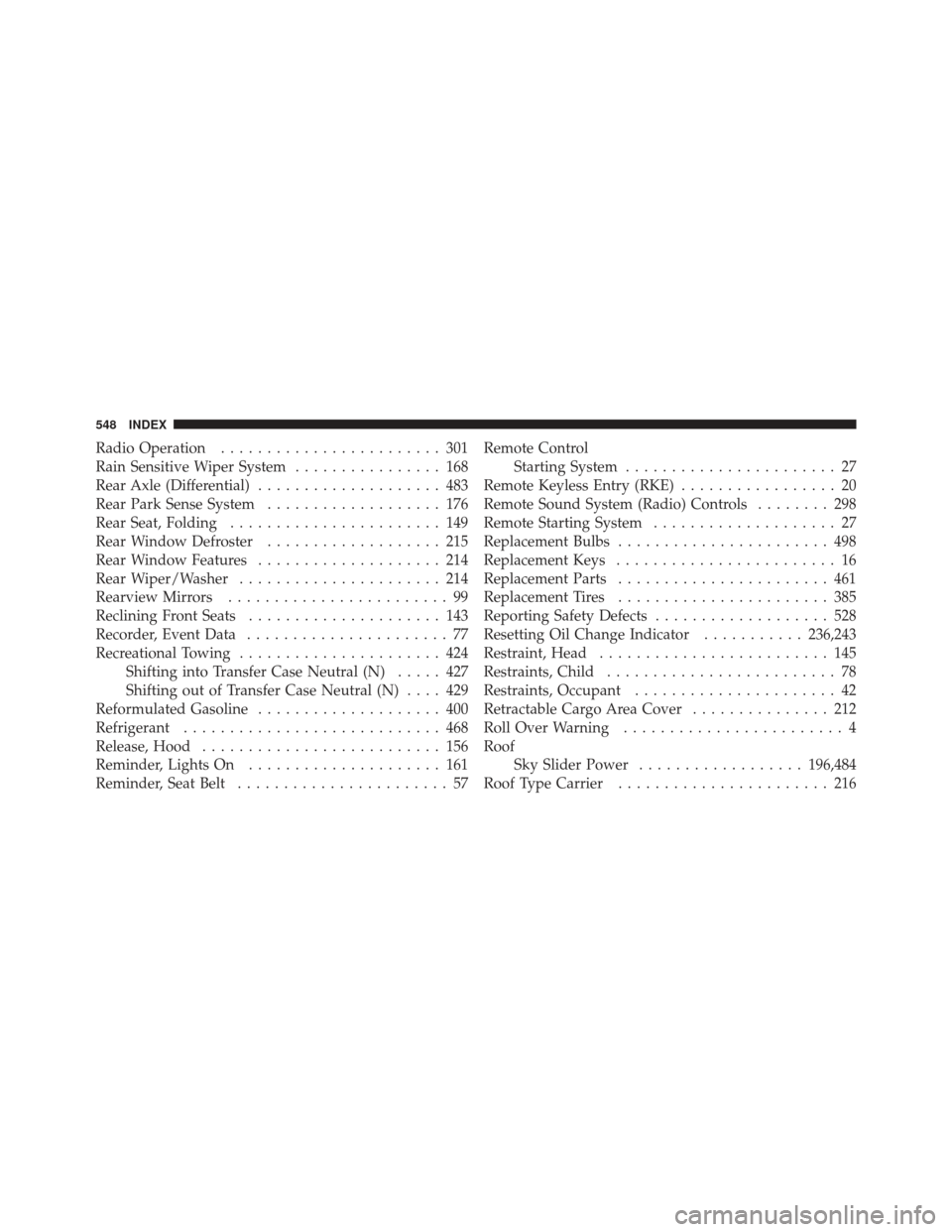gas type JEEP LIBERTY 2012 KK / 2.G Owners Manual
[x] Cancel search | Manufacturer: JEEP, Model Year: 2012, Model line: LIBERTY, Model: JEEP LIBERTY 2012 KK / 2.GPages: 558, PDF Size: 3.12 MB
Page 72 of 558

If there is a fault present in the air bag system, the Air Bag
Warning Light (a red light located in the center of the
instrument cluster directly in front of the driver) will be
turned on. This indicates that you should have an autho-
rized dealer service the system immediately. The Air Bag
Warning Light is turned on whenever there is a fault that
can affect the operation of the air bag system. If there is a
fault present in the PAD Indicator Light, the Air Bag
Warning Light will be illuminated to show that the
passenger Advanced Front Air Bag may be turned off
until the fault is cleared. If the Air Bag Warning Light is
illuminated, have an authorized dealer service the air bag
system immediately. If an object is lodged under the seat
and interferes with operation of the weight sensors, a
fault will occur which turns on both the PAD Indicator
Light and the Air Bag Warning Light. Once the lodged
object is removed, the fault will be automatically cleared
after a short period of time.Driver And Passenger Advanced Front Air Bag
Inflator Units
TheDriver And Passenger Advanced Front Air Bag
Inflator Units are located in the center of the steering
wheel and on the right side of the instrument panel.
When the ORC detects a collision requiring the Ad-
vanced Front Air Bags, it signals the inflator units. A large
quantity of non-toxic gas is generated to inflate the
Advanced Front Air Bags. Different air bag inflation rates
are possible based on collision severity and type. The
steering wheel hub trim cover and the upper right side of
the instrument panel separate and fold out of the way as
the air bags inflate to their full size. The air bags fully
inflate in about 50 to 70 milliseconds. This is about half of
the time it takes to blink your eyes. The air bags then
quickly deflate while helping to restrain the driver and
front passenger.
70 THINGS TO KNOW BEFORE STARTING YOUR VEHICLE
Page 73 of 558

The Advanced Front Air Bag gas is vented through the
vent holes in the sides of the air bag. In this way, the air
bags do not interfere with your control of the vehicle.
Along with seat belts and pretensioners, Advanced Front
Air Bags work with the knee bolsters to provide im-
proved protection for the driver and front passenger. Side
air bags also work with seat belts to improve occupant
protection.
Supplemental Side Air Bag Inflatable Curtains
(SABIC) Inflator Units
TheSupplemental Side Air Bag Inflatable Curtains
(SABIC) may deploy during rollovers and collisions
where the impact is confined to a particular area of the
side of the vehicle, depending on the severity and type of
collision. In these events, the ORC will deploy the SABIC
only on the impact side of the vehicle. Because air bag
sensors estimate deceleration over time, vehicle speed and damage by themselves are not good indicators of
whether or not an air bag should have deployed.
A quantity of non-toxic gas is generated to inflate the
SABIC. The inflating SABIC pushes the outside edge of
the headliner out of the way and covers the window. The
air bag inflates in about 30 milliseconds (about one
quarter of the time it takes to blink your eyes) with
enough force to injure you if you are not belted and
seated properly, or if items are positioned in the area
where the SABIC inflates. This especially applies to
children. The SABIC is only about 31�2inches (9 cm) thick
when it is inflated.
The system includes side impact sensors that are cali-
brated to deploy the side air bags during impacts that
require air bag occupant protection.
2
THINGS TO KNOW BEFORE STARTING YOUR VEHICLE 71
Page 480 of 558

If an examination of your engine compartment shows no
evidence of radiator or hose leaks, the vehicle may be
safely driven. The vapor will soon dissipate.
•Do not overfill the coolant bottle.
•Check coolant freeze point in the radiator and in the
coolant recovery bottle. If engine coolant (antifreeze)
needs to be added, contents of coolant recovery bottle
must also be protected against freezing.
•If frequent engine coolant (antifreeze) additions are
required, or if the level in the coolant recovery bottle
does not drop when the engine cools, the cooling
system should be pressure tested for leaks.
•Maintain engine coolant (antifreeze) concentration at
50% HOAT engine coolant (antifreeze) (minimum)
and distilled water for proper corrosion protection of
your engine, which contains aluminum components.
•Make sure that the radiator and coolant recovery
bottle hoses are not kinked or obstructed.
•Keep the front of the radiator clean. If your vehicle is
equipped with air conditioning, keep the front of the
condenser clean.
•Do not change the thermostat for Summer or Winter
operation. If replacement is ever necessary, install
ONLY the correct type thermostat. Other designs may
result in unsatisfactory cooling performance, poor gas
mileage, and increased emissions.
Brake System
In order to assure brake system performance, all brake
system components should be inspected periodically.
Refer to the “Maintenance Schedule” for the proper
maintenance intervals.
478 MAINTAINING YOUR VEHICLE
Page 550 of 558

Radio Operation........................ 301
Rain Sensitive Wiper System ................ 168
Rear Axle (Differential) .................... 483
Rear Park Sense System ................... 176
Rear Seat, Folding ....................... 149
Rear Window Defroster ................... 215
Rear Window Features .................... 214
Rear Wiper/Washer ...................... 214
Rearview Mirrors ........................ 99
Reclining Front Seats ..................... 143
Recorder, Event Data ...................... 77
Recreational Towing ...................... 424
Shifting into Transfer Case Neutral (N) ..... 427
Shifting out of Transfer Case Neutral (N) .... 429
Reformulated Gasoline .................... 400
Refrigerant ............................ 468
Release, Hood .......................... 156
Reminder, Lights On ..................... 161
Reminder, Seat Belt ....................... 57 Remote Control
Starting System ....................... 27
Remote Keyless Entry (RKE) ................. 20
Remote Sound System (Radio) Controls ........ 298
Remote Starting System .................... 27
Replacement Bulbs ....................... 498
Replacement Keys ........................ 16
Replacement Parts ....................... 461
Replacement Tires ....................... 385
Reporting Safety Defects ................... 528
Resetting Oil Change Indicator ...........236,243
Restraint, Head ......................... 145
Restraints, Child ......................... 78
Restraints, Occupant ...................... 42
Retractable Cargo Area Cover ............... 212
Roll Over Warning ........................ 4
Roof Sky Slider Power .................. 196,484
Roof Type Carrier ....................... 216
548 INDEX